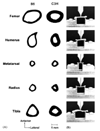Small animal bone biomechanics
- PMID: 18672104
- PMCID: PMC2586072
- DOI: 10.1016/j.bone.2008.06.013
Small animal bone biomechanics
Abstract
Animal models, in particular mice, offer the possibility of naturally achieving or genetically engineering a skeletal phenotype associated with disease and conducting destructive fracture tests on bone to determine the resulting change in bone's mechanical properties. Several recent developments, including nano- and micro-indentation testing, microtensile and microcompressive testing, and bending tests on notched whole bone specimens, offer the possibility to mechanically probe small animal bone and investigate the effects of aging, therapeutic treatments, disease, and genetic variation. In contrast to traditional strength tests on small animal bones, fracture mechanics tests display smaller variation and therefore offer the possibility of reducing sample sizes. This article provides an analysis of what such tests measure and proposes methods to reduce errors associated with testing smaller than ideal specimens.
Figures


Similar articles
-
Measurement of the toughness of bone: a tutorial with special reference to small animal studies.Bone. 2008 Nov;43(5):798-812. doi: 10.1016/j.bone.2008.04.027. Epub 2008 Jun 28. Bone. 2008. PMID: 18647665 Free PMC article. Review.
-
The biomechanical analysis of bone strength: a method and its application to platycnemia.Am J Phys Anthropol. 1976 May;44(3):489-505. doi: 10.1002/ajpa.1330440312. Am J Phys Anthropol. 1976. PMID: 937526
-
Microstructural and compositional contributions towards the mechanical behavior of aging human bone measured by cyclic and impact reference point indentation.Bone. 2016 Jun;87:37-43. doi: 10.1016/j.bone.2016.03.013. Epub 2016 Mar 26. Bone. 2016. PMID: 27021150 Free PMC article.
-
Biomechanics of Fractures.J Orthop Trauma. 2016 Aug;30 Suppl 2:S2-6. doi: 10.1097/BOT.0000000000000579. J Orthop Trauma. 2016. PMID: 27441928 Review.
-
Four-Point Bending Testing for Mechanical Assessment of Mouse Bone Structural Properties.Methods Mol Biol. 2021;2230:199-215. doi: 10.1007/978-1-0716-1028-2_12. Methods Mol Biol. 2021. PMID: 33197016
Cited by
-
Degradation of Bone Quality in a Transgenic Mouse Model of Alzheimer's Disease.J Bone Miner Res. 2022 Dec;37(12):2548-2565. doi: 10.1002/jbmr.4723. Epub 2022 Nov 1. J Bone Miner Res. 2022. PMID: 36250342 Free PMC article.
-
Bone fragility beyond strength and mineral density: Raman spectroscopy predicts femoral fracture toughness in a murine model of rheumatoid arthritis.J Biomech. 2013 Feb 22;46(4):723-30. doi: 10.1016/j.jbiomech.2012.11.039. Epub 2012 Dec 20. J Biomech. 2013. PMID: 23261243 Free PMC article.
-
Altered mechanical behavior of demineralized bone following therapeutic radiation.J Orthop Res. 2021 Apr;39(4):750-760. doi: 10.1002/jor.24868. Epub 2020 Oct 6. J Orthop Res. 2021. PMID: 32965711 Free PMC article.
-
Isolated Soy Protein Supplementation and Exercise Improve Fatigue-Related Biomarker Levels and Bone Strength in Ovariectomized Mice.Nutrients. 2018 Nov 17;10(11):1792. doi: 10.3390/nu10111792. Nutrients. 2018. PMID: 30453643 Free PMC article.
-
GLP-2 administration in ovariectomized mice enhances collagen maturity but did not improve bone strength.Bone Rep. 2020 Feb 5;12:100251. doi: 10.1016/j.bonr.2020.100251. eCollection 2020 Jun. Bone Rep. 2020. PMID: 32071954 Free PMC article.
References
-
- Ng AH, Wang SX, Turner CH, Beamer WG, Grynpas MD. Bone quality and bone strength in BXH recombinant inbred mice. Calcif Tissue Int. 2007 Sep;81(3):215–223. - PubMed
-
- Tang B, Ngan AH, Lu WW. An improved method for the measurement of mechanical properties of bone by nanoindentation. J Mater Sci Mater Med. 2007 Sep;18(9):1875–1881. - PubMed
-
- Kavukcuoglu NB, Denhardt DT, Guzelsu N, Mann AB. Osteopontin deficiency and aging on nanomechanics of mouse bone. J Biomed Mater Res A. 2007 Oct;83(1):136–144. - PubMed
-
- Akhter MP, Fan Z, Rho JY. Bone intrinsic material properties in three inbred mouse strains. Calcif Tissue Int. 2004 Nov;75(5):416–420. - PubMed
-
- McNamara LM, Ederveen AG, Lyons CG, Price C, Schaffler MB, Weinans H, Prendergast PJ. Strength of cancellous bone trabecular tissue from normal, ovariectomized and drug-treated rats over the course of ageing. Bone. 2006 Aug;39(2):392–400. - PubMed
Publication types
MeSH terms
Grants and funding
LinkOut - more resources
Full Text Sources

